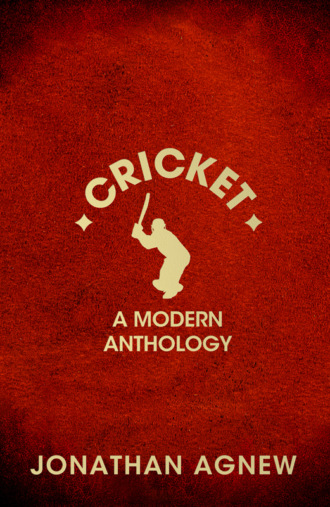
Полная версия
Cricket: A Modern Anthology
Australian cricket was rocked by the news that two of its favourites, Shane Warne and Mark Waugh, had both been given cash payments by an Indian bookmaker known only as John. Warne received A$5,000 and Waugh A$4,000 in exchange for what the players insist was nothing more than weather and pitch information before matches on their tour of Sri Lanka in 1994–5. An Australian journalist was tipped off that at least one Australian player was being paid by a bookmaker, and the officials were informed. Waugh and Warne admitted their involvement in unsigned handwritten statements, and the ACB chairman, Alan Crompton, fined the players. However, this was kept secret even from fellow members of the board who might have pressed for suspensions to be imposed. Another factor was that Waugh and Warne had both accused Salim Malik, the captain of Pakistan, of attempting to bribe them to lose matches and this information would have damaged their credibility as witnesses in the event of an inquiry.
But the scandal broke immediately before the Adelaide Test between Australia and England in December 1998 when Malcolm Conn, the Australian newspaper’s cricket correspondent, conducted his own investigation and published for the first time the connection with John, the mystery Indian bookie. In a packed media conference in the Adelaide pavilion, Warne and Waugh admitted to having been ‘naive and stupid’. The two players were vilified by the press and public alike, and Waugh received a hostile reception when he walked out to bat on the first day of the Test.
The initial reaction by the ACB does not come as a surprise. It was convenient in the dark decade of the 1990s for the finger of suspicion to point firmly at Pakistan. It is true that most of the rumours about corruption centred on Pakistan’s players, and their captain Salim Malik in particular. There appeared to be a determination among the game’s authorities to make an example of Malik, who in May 2000 became the first cricketer to be banned for match-fixing.
Malik’s fate was determined by Justice Malik Qayyum, a Pakistani judge, who was appointed by the Pakistan Cricket Board to examine allegations of corruption against members of the Pakistan team. In Qayyum’s report, Salim Malik was found guilty of match-fixing in Sri Lanka in 1994–5 and attempted match-fixing in Australia in 1994, and banned for life. Ata-ur-Rehman was also banned for life for ‘general match-fixing’. Other penalties were imposed on some of the best-known Pakistan cricketers. Wasim Akram was found ‘not to be above board’ and fined £3,700. Waqar Younis was censured and fined £1,200, as was Inzamam-ul-Haq. The leg-spinner Mushtaq Ahmed, who became England’s spin-bowling coach, was fined £3,700. Six years later, Qayyum admitted that he had been lenient on some players, including Wasim Akram, because he had a soft spot for them and was a fan.
The scale of corruption within cricket only surfaced for the first time when the shocking news broke that Hansie Cronje, a man who in South Africa would be ranked only one division below Nelson Mandela in terms of popularity and standing, was suspected of match-fixing. The source was the Delhi police force, which, in April 2000, made public the details of a taped telephone conversation between Cronje and a known bookmaker, Sanjay Chawla. Cronje initially denied the allegations but quickly admitted his guilt in exchange for immunity from prosecution in South Africa. The Indian captain, Mohammad Azharuddin, was also seriously implicated and they both received life bans from the game. During the King Commission of Inquiry, details emerged of Cronje’s largely unsuccessful attempts to corrupt a number of his team-mates. Depressingly, these were generally the most vulnerable, either through race or by being on the fringe of selection, and therefore the easiest to influence. Henry Williams, a black pace bowler, testified that he was offered US$15,000 to bowl badly in a one-day international against India, and Herschelle Gibbs, the opening batsman, the same amount to score fewer than 20 runs. As a result of the evidence, both players were fined and suspended by the South African board for six months.
From an English perspective, the most absorbing details to emerge centred on a rain-affected Test match played between South Africa and England at Pretoria in January 2000. At the start of the last day of the final Test, only forty-five overs had been possible throughout the match, and South Africa, in their first innings, were 155 for six. A number of suggestions for making something from nothing had already been dismissed by the administrators. South Africa had already won the series so there was nothing at stake in that regard and, strongly persuaded by Cronje, the England captain, Nasser Hussain, agreed to forfeit England’s first innings in exchange for South Africa reaching a pre-agreed total of 250 and forfeiting their second innings in order to set up the prospect of an interesting day’s cricket. This went down very well with the thousand or so England supporters who had made the trip and who were mighty frustrated, and it was hailed from the press and commentary boxes as a great day for cricket. Not everyone agreed, particularly those who had an interest in horse racing. Mike Atherton was a dissenter within the England ranks, while Sir Ian Botham and the journalist Jack Bannister were vociferous in their disapproval behind the scenes. Effectively, the draw – a nailed-on certainty – was suddenly made vulnerable, and this caused alarm in legitimate betting circles where the book had already been closed.
Under the contrived arrangement, England were set 249 to win, which they achieved with just two wickets and five balls remaining, ensuring that the spectators had their entertainment. However, what was known only to Cronje was that, on the evening before the final day, he was approached by a South African bookmaker, Marlon Aronstam, who offered to give 500,000 rand (approximately £33,300) to the charity of Cronje’s choice if he declared to make a game of it. When the match was over, Aronstam gave Cronje two payments totalling 50,000 rand (£3,300) and a leather jacket.
Although a large number of South Africans refused point blank to believe a word of the evidence against their national hero, Cronje’s fall from grace was dramatic and ultimately tragic. On 1 June 2002, aged 32, he died in a plane crash in mountains near George in South Africa. Inevitably, conspiracy theories flourished in the immediate aftermath, and then again in 2007 when Bob Woolmer – who had been Cronje’s coach and confidant – was found dead in his Jamaican hotel room. Woolmer was coach of Pakistan at the time, and his team had just been knocked out of the World Cup at the earliest opportunity as a result of a surprise loss to Ireland. The inquests recorded death by pilot error in Cronje’s case, but returned an open verdict in Woolmer’s, which left open the possibility that he had been murdered. However, a review of the case by Scotland Yard determined that Woolmer had died of natural causes, most probably a heart attack.
Aware of the damage that was being done to the integrity of the game, the ICC set about tackling the most serious issue the game had ever faced. An anti-corruption unit was set up, which brought in a raft of stringent measures designed to increase awareness among the players and also to make contact with bookmakers more difficult. A zero-tolerance policy was introduced, leaving no one in any doubt that corrupt players would be heavily punished. It was widely accepted, however, that spot-fixing, in particular, would be very difficult to prove. This might involve the number of runs scored by a team during a specified passage of play in a one-day match, or even the outcome of a single delivery. A bowler delivering a wide or no-ball to order is all that is required for bookies to make a killing on the cricket-crazy, illegal betting markets on the Indian subcontinent.
Allegations of match-fixing, in which games were deliberately thrown by the majority of a team, went quiet after Cronje’s case because of the increased awareness of administrators, umpires and the media. However, this probably allowed spot-fixing to proliferate as the bookies were forced to change their approach. Cricket had lost its innocence in that the simplest dropped catch, inexplicable run-out or mysteriously slow innings now raises eyebrows. But it is one thing to harbour a suspicion in the commentary box, and quite another to make a serious allegation against a professional cricketer who might be guilty of nothing more than making a mistake.
The tour of England by the Pakistan team in the summer of 2010 provided a significant victory in the battle against corruption, although it took a sting by the Sunday tabloid newspaper the News of the World to bring it about. Sharp-eyed commentators working at the Lord’s Test – the final match of the summer – were surprised to see Mohammad Amir, the 18-year-old swing bowler, deliver two no-balls. But these were not ordinary no-balls: he overstepped the crease by a remarkable distance, and yet still released the ball, something that was impossible to explain.
It all became clear on the Sunday morning, which was the final day of the match, when the News of the World exposed the set-up in which an agent, Mazhar Majeed, was seen accepting £150,000 from the undercover reporter. The deal was that Majeed would arrange for three no-balls to be delivered to order, two by Amir and one by Mohammad Asif. Sure enough, the no-balls were bowled precisely as specified, and the Pakistan captain, Salman Butt, was revealed as the man who had passed the instructions to his bowlers.
The evidence appeared to be conclusive, and this was the verdict of the ICC, which conducted a disciplinary hearing despite the ongoing criminal investigation. All three players were found guilty and, on 5 February 2011, received lengthy bans – Butt for ten years, with five suspended; Asif seven years, with two suspended; and Amir five years. The players maintained their innocence, but in November 2011 were found guilty at Southwark Crown Court of conspiracy to cheat at gambling and conspiracy to receive corrupt payments. Butt was jailed for two and a half years, Asif for one year and Amir for six months. The agent, Majeed, was imprisoned for two years eight months. The case was seen as a watershed moment in the battle that every sport faces against corruption, and it forced Pakistan’s authorities finally to take seriously the long-held view that its cricket team was more exposed to corruption than any other.
However, there was a shock in store for followers of county cricket when, in January 2012, a young Essex fast bowler, Mervyn Westfield, pleaded guilty to accepting £6,000 to deliberately under-perform in a match against Durham in 2009. He was imprisoned for four months after alleging in court that he had been persuaded to accept the bribe by the Pakistan and Essex leg-spinner, Danish Kaneria, who had been initially arrested with Westfield. Kaneria was released without charge, and denies Westfield’s allegations. However, the case underlines the extent to which corruption has infiltrated the game of cricket and that, potentially, any match televised live to the Indian subcontinent is at risk.
Why is it that cricket has attracted so many controversies over its relatively short life? Racism, corruption, politics – the great game has endured more than its fair share of issues, all of which have threatened its welfare. At least part of the answer must lie in the fact that it is a traditional sport founded upon a strict moral code of fair play and sporting conduct. Any threat to those principles is big news, and I am quite convinced that cricket crises – particularly of the political variety – make bigger headlines even than football crises because of the game’s historical links with the Commonwealth.
It is a fact that cricket has at times played a crucial role in shaping the world in which we live. This is plain to see in the D’Oliveira crisis, which made a nonsense of the often cowardly ambition of many to keep sport separate from politics. Separating the two is almost impossible to achieve and, besides, when you consider the dismantling of apartheid, sport – and cricket in particular – made a significant contribution. The D’Oliveira affair led directly to the 1977 Gleneagles Agreement in which Commonwealth leaders agreed to boycott all sporting contact with South Africa as part of the international fight against apartheid. Supporters of the rebel cricket tours that broke that agreement will say that the English XI tour in 1990, led by Mike Gatting, played a part in speeding up the end of the reviled political system in South Africa. It did, but not because it was the right thing to do. The ill-timed and insensitive tour was a financial disaster for the South African Cricket Union, coinciding as it did with the unbanning of the African National Congress and Nelson Mandela’s release from prison. The tour became a focal point for demonstrators – Gatting famously admitted to hearing a ‘few people singing and dancing’ outside his hotel – and it quickly became obvious that the tour was unsustainable, and was called off.
Sport and politics are inextricably linked, but the type of sustained pressure that worked against South Africa does not work in every situation. It would not, for example, have made the slightest impression on Robert Mugabe’s stranglehold on South Africa’s neighbour, Zimbabwe, because sport does not play such a strong part in that country’s everyday life. However, an England cricket tour to Zimbabwe in 2003 did allow a precious opportunity for Western journalists – banned at the time by the regime – including myself to enter the country. Once inside, we were able to report on life within the country, from the consequences of rampant inflation to the witnessing of farms being burned to the ground.
It might be everyone’s ideal to keep sport and politics as far apart as possible, but not only is that naive, but it also denies sport the opportunity to play its part in civilizing society and improving lives. A number of great South African cricketers had their international careers ruined by the Gleneagles Agreement, and have every reason to be bitter towards the politicians who drove their own country into sporting isolation. Mike Procter, as fine an all-rounder as there has ever been, was restricted to just seven Tests before the curtain came down. ‘What’s one life,’ he asked me, ‘compared to the millions who were liberated?’

Конец ознакомительного фрагмента.
Текст предоставлен ООО «ЛитРес».
Прочитайте эту книгу целиком, купив полную легальную версию на ЛитРес.
Безопасно оплатить книгу можно банковской картой Visa, MasterCard, Maestro, со счета мобильного телефона, с платежного терминала, в салоне МТС или Связной, через PayPal, WebMoney, Яндекс.Деньги, QIWI Кошелек, бонусными картами или другим удобным Вам способом.




